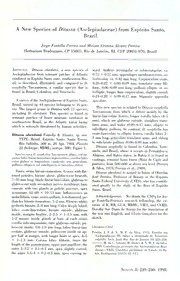
A new species of Ditassa (Asclepiadaceae) from Espi|rito Santo, Brazil PDF
Preview A new species of Ditassa (Asclepiadaceae) from Espi|rito Santo, Brazil
A New Species of Ditassa (Asclepiadaceae) from Espirito Santo, Brazil Jorge Fontella Pereira and Miriam Cristina Alvarez Pereira Herbarium Bradeanum, CP 15005, Rio de Janeiro, RJ, CEP 20031-970, Brazil Abstract. Ditassa oberdanii, a new species of ward. Anthers rectangular or subrectangular, ca. Asclepiadaceae from remnant patches of Atlantic 0.75 X 0.57 mm, appendages membranaceous, su- rainforest in Espirito Santo state, southeastern Bra¬ borbicular, ca. 0.42 mm long. Corpusculum ovate, zil, is described, illustrated, and compared to D. 0.20—0.22 X 0.08-0.09 mm; translator arms fili¬ oxyphylla Turczaninow, a similar species that is form, 0.06—0.09 mm long; pollinia elliptic or su- found in Brazil, Colombia, and Venezuela. belliptic, longer than corpusculum, slightly curved, 0.24—0.28 X 0.09—0.17 mm. Stigmatic appendix A survey of the Asclepiadaceae of Espirito Santo, apiculate. Brazil, turned up 44 species belonging to 16 gen¬ This new species is related to Ditassa oxyphylla era. The largest genus is Ditassa with 11 species, Turczaninow, from which it differs mainly by the including D. oberdanii. This species is found in linear-lanceolate leaves, longer corolla lobes (4—5 remnant patches of lower montane rainforest in mm), which are glabrous outside, straighter trans¬ southeastern Brazil, in the Atlantic forest biome lator arms, and wider (0.09—0.17 mm), elliptic to which is seriously threatened by human activities. subelliptic pollinia. In contrast, D. oxyphylla has ovate-lanceolate to elliptic leaves, corolla lobes 2— Ditassa oberdanii Fontella & Alvarez, sp. nov. 3 mm long, geniculate translator arms, and oblong TYPE: Brazil. Espirito Santo: Santa Teresa, to subelavate pollinia (0.06-0.08 mm wide). Rio Saltinho, 500 m, 26 Apr. 1984, Pizziolo Ditassa oxyphylla is found in Colombia, Vene¬ 22 (holotype, MB ML; isotype, HB). Figure 1. zuela, and Brazil, where it occurs in Pernambuco, Species nova D. oxyphyllae Turczaninow affmis, sed im¬ Alagoas, and Bahia states; in Bahia it is found in primis foliis linear-lanceolatis angustioribus, corollae lobis caatinga, remnant liana forest (Mata de Cipo) and extus glabris et longioribus, caudiculis non geniculatis, pastures, from 500-600 m above sea level (Pereira polliniis ellipticis vel subellipticis et latioribus differt. & Silva, 1973; Pereira et al., 1989). Vines; stems hirsute-tomentose. Leaves with flat¬ Ditassa oberdanii is named in honor of Oberdan tened petioles, hirsute above, glabrescent beneath, Jose Pereira, Professor of Botany at the Espirito 7-10 mm long; blade linear-lanceolate, glabrous to Santo Federal University (UFES), who has contrib¬ glabrescent with secondary nerves rectilinear, base uted greatly to the study of the flora of Espirito cuneate with two glands at petiole juncture, apex Santo, Brazil. acuminate, 61—69 X 10—13 mm. Inflorescence an umbelliform cyme, extra-axillary, 3—6-flowered; pe¬ Acknowledgments. We thank the CNPq for Jor¬ duncles hirsute-tomentose, 1-2 mm. Flowers white; ge Fontella-Pereira’s research fellowship, the cu¬ pedicels hirsute, 2—^ mm long. Calyx deeply lobed; rators of R, RB, GUA, MBML, VIES, and CVRD, lobes ovate-lanceolate, hirsute outside, glabrous Dorothy Sue Dunn de Araujo for the translation of inside, margins hyaline, 2-2.5 X 1—1.5 mm, with the text into English, and Gloria Gonsalves for the 1-2 minute inside glands at base of each sinus; sketch. corolla subcampanulate; tube glabrous outside, pu¬ bescent inside, 0.8—1.0 mm long; lobes linear-lan¬ Literature Cited ceolate, glabrous outside, pubescent inside on up¬ Pereira, .1. F. & N. M. F. da Silva. 1973. Estudos em per half at margin, with longer hairs at apex, 4-5 Asclepiadaceae III. Sobre a identidade de Nemaluris X 1—1.3 mm. Corona lobes filiform, twice the volubilis. Arch. Jard. Bot. Bio de Janeiro 19: 223-226 -, M. da C. Valente, B. Harley & N. M. F. da Silva. length of the gynostegium, upper part papillose, the 1989. Contribuiyao ao estudo das Asclepiadaceae Bras- outer 3—3.2 X 0.1—0.3 mm, apex slightly curved, ileiras—XXIV. Checklist preliminar do Estado da Ba¬ the inner 3.5-A X 0.2—0.3 mm, apex curving in¬ hia. Rodrigu6sia 41(67): 81-115. Novon 8: 239-240. 1998. 240 Novon
